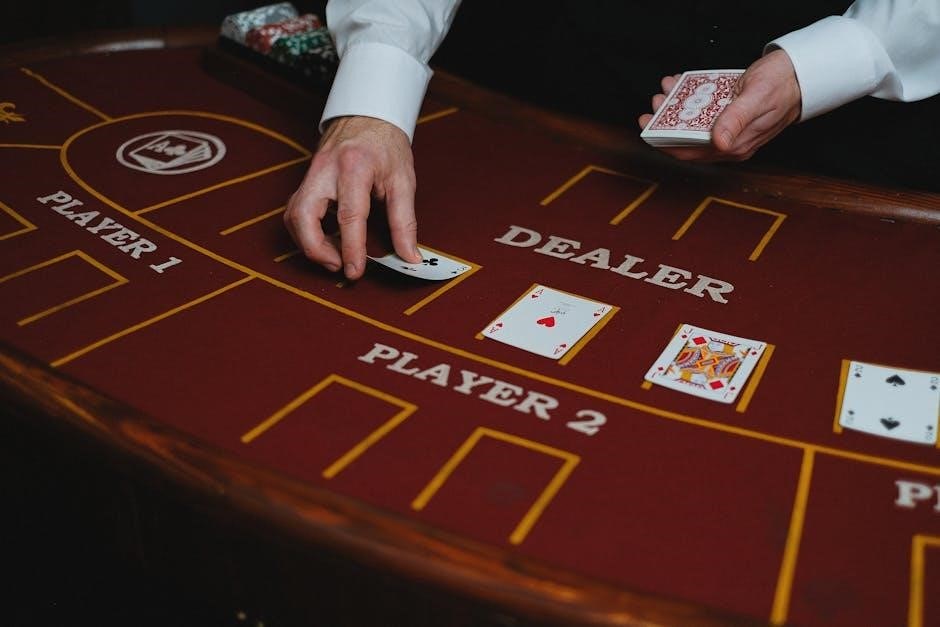
hand and foot card game instructions
Hand and Foot is a variant of Canasta, typically played with 4-6 players using multiple decks. Jokers are wild, and players must meld cards into sets of 3-7. The game involves two rounds: first playing the “hand,” then the “foot.”

Objective of the Game
The primary objective of Hand and Foot is to be the first player or team to eliminate all the cards in both their “hand” and “foot” by forming valid melds. A meld consists of three to seven cards of the same rank, which can include wild cards like Jokers and Deuces. Players must first play all the cards in their hand before moving on to their foot. The goal is not only to get rid of your cards but also to score the most points by creating melds. Points are awarded based on the cards used in the melds, with wild cards and certain ranks carrying higher values. The game emphasizes strategy, as players must carefully plan when to meld and how to use wild cards effectively. Teamplay is also a key aspect, as coordination between teammates can lead to higher scores. Ultimately, the player or team with the most points at the end of the game is declared the winner. Mastery of the melding rules and efficient use of wild cards are crucial to achieving success in Hand and Foot.

How to Deal the Cards
Dealing the cards is a crucial step in setting up the Hand and Foot game. The game typically uses five to six standard decks of 52 cards, including Jokers, depending on the number of players. For two players, two decks are used, while for four to six players, five to six decks are combined. The decks are shuffled together to create a single large stockpile. Each player is then dealt two separate sets of cards: the “hand” and the “foot.” The hand consists of 11 cards, and the foot also contains 11 cards. In some variations, the dealer receives 15 cards for their hand, while other players receive 13 cards for their hand and 11 for their foot; The remaining cards are placed face down in the center of the table to form the stockpile, which players will draw from during the game. The dealer is determined by a high-card draw, with the highest card going to the player who deals first. This setup ensures that each player has an equal opportunity to start the game with a balanced set of cards. The dealing process is essential for maintaining fairness and structure in the game.
Card Values and Scoring
In Hand and Foot, each card has a specific point value that contributes to the overall score; Jokers, which act as wild cards, are worth 50 points each, while Deuces (2s) are valued at 20 points each. Aces are also worth 20 points. Cards from 8 through King are worth 10 points each, and cards from 3 through 7 are worth 5 points each. The scoring system is designed to reward players for creating valid melds and penalizing those who cannot meld all their cards. At the end of the game, the points from all melded cards are added up for each player or team. Players also receive penalties for any cards left in their hand or foot that were not melded. The goal is to accumulate the highest score by efficiently using wild cards and strategically melding high-value cards. Proper management of card values is crucial for maximizing points and securing a win.
Meld Rules
In Hand and Foot, a meld is a set of 3 to 7 cards of the same rank. To form a valid meld, players must lay down a group of cards that meet specific criteria. Wild cards, such as Jokers and Deuces, can be used to substitute for missing cards in a meld, but they cannot outnumber the natural cards in the set. For example, a meld of four cards can include no more than one wild card. Once a wild card is used in a meld, it cannot be moved or repurposed in another meld during the same game.
A player can only meld during their turn and must announce the meld clearly. Melds can be added to by other players on their turns, but only if the additional cards are natural and match the rank of the meld. A player cannot meld until they have met the initial meld requirement, which varies by round but is typically based on the game’s scoring structure. Teams must also ensure that all members have played at least one round with their foot before the game can end. Proper adherence to meld rules is essential for fair play and scoring accuracy.
Wild Cards and Their Usage
In Hand and Foot, wild cards play a crucial role in helping players complete melds. Jokers and Deuces (2s) are designated as wild cards, meaning they can substitute for any natural card in a meld. Jokers are worth 50 points each, while Deuces are worth 20 points. Wild cards can be used to fill gaps in a meld, but their usage is subject to specific rules.
A meld must always contain more natural cards than wild cards. For example, a meld of five cards can include no more than one wild card. This ensures that the integrity of the meld is maintained. Additionally, once a wild card has been used in a meld, it cannot be moved or reused in another meld during the same game. This restriction prevents players from gaining an unfair advantage by reusing wild cards across multiple sets.
Players can strategically use wild cards to complete difficult melds or to enhance their scoring potential. However, over-reliance on wild cards can lead to inefficiencies, as they are limited in number and high in value. Balancing the use of wild cards with natural cards is key to successful gameplay. By adhering to these rules, players ensure a fair and enjoyable experience for everyone involved.
Gameplay Steps
The game begins with each player receiving two sets of cards: the “Hand” and the “Foot.” The Hand pile is played first, while the Foot remains face down until the Hand is fully used. Players take turns drawing a card from the stockpile and attempting to meld cards into sets or runs.
Melding is central to gameplay. A valid meld consists of three to seven cards of the same rank or a sequential run of at least three cards. Players can also add to existing melds on the table. Wild cards (Jokers and Deuces) can substitute for missing cards but must follow specific usage rules.
After drawing, a player must discard one card from their Hand or Foot pile. If a player has melded all cards in their Hand, they can begin playing their Foot pile. The round ends when a player successfully discards all their cards, winning the round and earning points for their team.
Each round progresses through stages, with increasing point thresholds for initial melds. The game is typically played to a total of 150 points, with the team achieving this score first declared the winner. Proper strategy and communication are key to success in this dynamic card game.
Going Out and Winning the Game
Going out is achieved when a player successfully discards all cards from both their Hand and Foot piles. To win, a player must first clear their Hand, then proceed to play through their Foot. A player cannot begin using their Foot until their Hand is entirely discarded.
The game is won by the player or team that accumulates the most points through melding cards. Points are awarded based on the cards melded, with wild cards and specific card ranks carrying higher values. The round concludes when a player empties both their Hand and Foot, triggering the final scoring phase.
A player must declare “Going out” before their final discard to alert opponents. If they succeed, they earn a bonus for going out. The opponent’s remaining cards are penalized, deducting points from their total. Teams strategize to coordinate melds and plan their discards carefully to maximize points and win the game.
Scoring Points
Scoring in Hand and Foot is based on the value of the cards melded during the game. Jokers and deuces act as wild cards, each worth 50 and 20 points, respectively. Aces are valued at 20 points, while face cards (Kings, Queens, Jacks) and eights are worth 10 points each. Numbered cards from threes to sevens are worth 5 points each.
Players earn points by forming valid melds, which are sets of three to seven cards of the same rank. Wild cards can be used to complete melds but cannot outnumber natural cards in a set. The game also awards bonus points for going out, which is clearing both the Hand and Foot piles entirely.
Penalties are applied for any cards remaining in a player’s Hand or Foot at the end of the game. These penalties are deducted from the player’s total score. The winner is determined by the highest accumulated points, making strategic melding and efficient card play crucial to success.
Scoring is cumulative, and games are often played over multiple rounds. The player or team with the highest total points at the end of all rounds is declared the winner.
Special Rules
In Hand and Foot, certain rules are essential to ensure smooth gameplay. One key rule is that wild cards, such as Jokers and deuces, cannot be moved once melded. This means that once a wild card is placed in a meld, it cannot be relocated to another set. Additionally, a meld must always contain more natural cards than wild cards, ensuring that the game retains its strategic depth.

Another important rule is that players must fully clear their Hand pile before they can start playing their Foot pile. If a player has cards left in their Hand, they must continue focusing on it until it’s emptied. This rule adds a layer of complexity, as players must manage both piles strategically.
Moreover, the game specifies that each meld must consist of at least three cards, and no more than seven. This range encourages players to form substantial sets but also prevents overly long melds from dominating the game. These special rules are designed to balance fun and strategy, making Hand and Foot a dynamic and engaging card game for players of all skill levels.
Team Play Dynamics
Hand and Foot is often enjoyed as a team-based game, fostering collaboration and strategy between players. Teams typically consist of two players each, though variations allow for larger groups. Communication is key, as teammates must work together to meld cards effectively and maximize their score. A critical aspect of team play is ensuring that all players contribute to the melding process, as the game requires coordination to achieve common goals.
One unique rule in team play is that at least one player on each team must completely play their Hand and Foot piles. This ensures that every team member is actively involved in the game. Additionally, teams must strategize about when to meld cards, as timing can significantly impact the outcome. Players often sacrifice individual opportunities to discard or meld cards to benefit the team’s overall progress.
The dynamic between teammates is crucial, as they must balance their individual strategies with collective goals. This teamwork element makes Hand and Foot not only a game of skill but also one of trust and coordination. Whether playing with two players or larger teams, the interplay between partners enhances the game’s excitement and complexity.
Variations of the Game
Hand and Foot offers several variations to suit different player preferences and skill levels. One common variation involves the number of decks used, with some games incorporating five to six decks, while others may use fewer. Additionally, the number of players can vary, with options for 2-6 players, making it adaptable for both small and larger groups.
Another variation is the scoring system, where some players opt for simpler point calculations, focusing only on specific card values like Jokers and Deuces. In some versions, bonus points are awarded for particularly challenging melds, adding an extra layer of strategy. House rules also play a role, as families or communities often customize the game to suit their preferences.
Regional variations exist as well, with some areas introducing unique melding rules or additional wild cards. For instance, in some regions, Eights are treated as wild cards alongside Jokers and Deuces. These variations keep the game fresh and exciting, allowing players to experiment with different styles and challenges.
Overall, the flexibility of Hand and Foot ensures that it remains a dynamic and engaging card game for players of all backgrounds and experience levels.
Learning Resources
Mastering Hand and Foot is made easier with a variety of learning resources available to players of all skill levels. For beginners, video tutorials provide step-by-step guides on dealing, melding, and scoring, offering a visual and interactive way to grasp the game’s fundamentals. Websites dedicated to card games often feature detailed rule breakdowns, strategy tips, and common mistakes to avoid, ensuring a smooth learning curve.
Mobile apps and online platforms allow players to practice against virtual opponents, honing their skills in a risk-free environment. These tools often include features like card sounds and animations, enhancing the learning experience. Additionally, downloadable PDF guides offer comprehensive rulebooks, perfect for offline study and reference.
Books on card games frequently include chapters dedicated to Hand and Foot, providing in-depth insights into advanced strategies and variations. Furthermore, joining online forums or local card game communities connects learners with experienced players, fostering knowledge sharing and camaraderie. With these resources, new players can quickly become proficient and enjoy the game’s excitement.
Whether through digital tools or traditional materials, there’s a wealth of resources available to help anyone learn and excel at Hand and Foot.
Strategy Tips
Mastering Hand and Foot requires a blend of skill and strategy; One key tip is to prioritize melding natural cards early, as wild cards can be unpredictable. Focus on creating strong foundations with common ranks to maximize scoring opportunities.
Keep track of discarded cards to anticipate opponents’ moves and avoid unintentionally aiding their melds. Managing your hand and foot piles strategically ensures you can play efficiently. Communicate effectively with teammates to coordinate melds and optimize scoring.
Avoid holding onto wild cards too long, as they are valuable but can become liabilities if unused. Timing is crucial; aim to meld high-value cards early to reduce penalties. Practice recognizing patterns in opponents’ discards to anticipate their strategies and adapt your play.
By combining these tactics with a keen understanding of the game’s rules, you can significantly improve your chances of winning. Consistent practice and adaptability are essential for long-term success in Hand and Foot.
Common Mistakes to Avoid
One of the most frequent mistakes in Hand and Foot is improper use of wild cards. Players often over-rely on Jokers and Deuces, which can lead to missed opportunities for natural melds. Another common error is failing to plan ahead for discarding, which can leave you unable to play your foot pile efficiently.
Neglecting to communicate with teammates in team play is another costly mistake. Coordination is key to maximizing points and avoiding penalties. Additionally, players often overlook the importance of tracking discarded cards, which can provide valuable insights into opponents’ strategies.
Avoid the habit of holding onto low-value cards too long, as they can clog your hand and prevent you from forming meaningful melds. Similarly, rushing to meld without a clear plan can leave you vulnerable to opponents’ moves. Players should also be cautious not to discard cards that could complete an opponent’s meld, unintentionally aiding their progress.
By being mindful of these common pitfalls, players can avoid unnecessary setbacks and improve their overall gameplay. Awareness and adaptability are crucial to mastering Hand and Foot.
House Rules and Customizations
House rules and customizations are common in Hand and Foot, allowing players to tailor the game to their preferences. One popular variation is adjusting the number of decks used, with some groups opting for fewer decks to simplify gameplay. Others modify the scoring system, such as reducing the points for wild cards or altering the penalties for unmelded cards.
Some players introduce a “speed play” rule, where the game ends immediately when one player goes out, rather than requiring others to finish their turns. Another customization is the “freeze out” rule, where players who fail to meld within a set number of turns are eliminated. Themed rounds, such as “no wild cards” or “all natural melds,” can also add variety to the game.
Team dynamics can be altered by allowing silent communication or restricting the number of times a team can lay off cards. Some groups even create unique penalties, like forcing losing players to perform a fun task. These customizations make Hand and Foot adaptable to different skill levels and playstyles, ensuring the game remains engaging for everyone involved.
By incorporating house rules, players can personalize the game and keep it fresh, making each session unique and enjoyable.

History of the Game
Hand and Foot, a popular card game, has its roots in Canasta, a rummy-style game that originated in Uruguay in the 1930s. As Canasta gained global popularity, variations emerged, and Hand and Foot became a distinct version, particularly favored in North America. Its name comes from the two sets of cards each player holds: the “hand” and the “foot.”
The game’s development is tied to the rise of social card games in the mid-20th century. It became a staple at family gatherings and community events, known for its strategic depth and accessibility. Over time, players introduced regional and household modifications, leading to diverse rule sets while maintaining the core objective of melding cards efficiently.
Hand and Foot’s evolution reflects the adaptability of card games to cultural preferences. Its enduring appeal lies in its balance of strategy and simplicity, making it a beloved activity across generations. The game’s history is a testament to the creativity of players worldwide who have shaped it into the engaging pastime it is today.
Popularity and Cultural Impact
Hand and Foot has grown into a beloved card game, particularly in North America, due to its engaging gameplay and social nature. Its popularity stems from its accessibility, making it a staple at family gatherings, community events, and casual meetups. The game’s ability to accommodate 2 to 6 players further enhances its appeal, allowing it to be enjoyed in various settings.
Culturally, Hand and Foot has become a bonding activity across generations. It is often passed down within families, with older generations teaching younger ones the rules and strategies. This intergenerational aspect has helped maintain its relevance in an era dominated by digital entertainment. The game’s portability and simplicity also make it a favorite for travelers and those seeking low-tech, face-to-face interaction.
Moreover, Hand and Foot has inspired a sense of community among players. Local tournaments and online forums dedicated to the game highlight its enduring appeal. Its influence extends beyond mere entertainment, fostering camaraderie and mental stimulation. As a result, Hand and Foot remains a cherished part of many people’s leisure activities, bridging gaps between traditional and modern forms of social interaction.
Tournaments and Competitive Play
Hand and Foot has a thriving competitive scene, with tournaments organized by card game clubs and communities. While it is not as widely recognized as other card games, its strategic depth and team-based dynamics make it a favorite among competitive players. Local and regional tournaments are common, often attracting seasoned players looking to test their skills.
Competitive play typically follows standardized rules to ensure fairness and consistency. Tournaments are usually team-based, with teams of 2-4 players, and involve multiple rounds of play. Winners are determined by the highest cumulative score or by being the first team to go out in the final round. Prizes may include trophies, cash awards, or bragging rights.
The rise of online platforms has further fueled competitive Hand and Foot, allowing players to compete globally. Virtual tournaments are gaining popularity, offering a convenient way for enthusiasts to engage in high-stakes games. As the game’s popularity grows, so does its competitive landscape, making it an exciting option for those who enjoy strategic card games.
Technological Adaptations
The Hand and Foot card game has been adapted into various digital formats, making it accessible to a wider audience. Mobile apps and online platforms now offer virtual versions of the game, allowing players to enjoy it on smartphones, tablets, and computers. These digital adaptations often feature sleek designs, animations, and sound effects to enhance the gaming experience.
Some apps include AI opponents, enabling solo play against virtual players, while others offer multiplayer modes for competitive or cooperative team play. Many platforms also provide tutorials and rule guides for newcomers, making it easier to learn the game. Additionally, online communities and forums dedicated to Hand and Foot allow players to share strategies, tips, and house rules.
Digital versions often include features like automatic scoring, card tracking, and reminders for melding opportunities, simplifying gameplay. Notifications for turns and special events keep players engaged, while leaderboards foster a sense of competition. These technological adaptations have helped preserve and popularize the game, ensuring its longevity in the digital age.

Hand and Foot is a dynamic and engaging card game that offers a perfect blend of strategy and fun. Its versatility allows it to be enjoyed by players of all skill levels, whether in casual gatherings or competitive tournaments. The game’s structure, with its unique hand and foot piles, adds a layer of complexity that keeps players entertained and challenged.
The ability to customize rules and adapt the game to personal preferences makes it a favorite among card game enthusiasts. Whether played individually or in teams, Hand and Foot fosters camaraderie and healthy competition. Its rich history and evolution into digital formats ensure its continued popularity in the modern era.
For newcomers, the game’s intuitive nature and step-by-step learning process make it easy to pick up. Experienced players will appreciate the depth of strategy and the thrill of outsmarting opponents. With its timeless appeal, Hand and Foot remains a beloved choice for card game lovers worldwide. So gather your friends, shuffle the decks, and dive into this exciting game that promises hours of enjoyment!
Next Steps for Beginners
Once you’ve learned the basic rules of Hand and Foot, the next step is to practice regularly to build familiarity with the game. Start by playing with a friend or family member who is experienced, as they can guide you through the gameplay. Begin with simpler variations of the game, such as playing with fewer decks or focusing solely on melding, to ease into the mechanics.
Watch online tutorials or download apps that simulate the game to observe how experienced players strategize. Pay attention to how they manage their hand and foot piles, use wild cards effectively, and plan their melds. Join online forums or local card game communities to connect with other players and learn tips and tricks.
Keep track of your progress by noting what strategies work best for you and which mistakes to avoid. As you gain confidence, gradually incorporate more advanced rules, such as team play or higher point requirements for melding. Remember, the key to improving is consistent practice and a willingness to learn from each game.
Most importantly, enjoy the process of mastering Hand and Foot. It’s a game that combines skill and luck, making it both challenging and rewarding. Happy gaming!